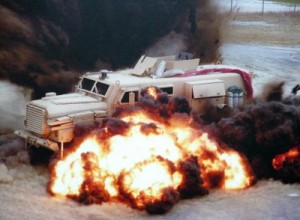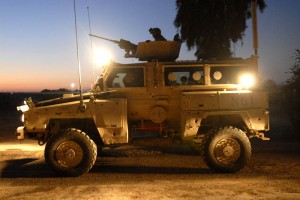
Once again our latest military equipment has developed an Achilles Heel.
A few years ago the big controversy was the necessity to build new armored HUMVEES for the military, or convert older ones by “up-armoring.” Critics of the Defense Department badgered the military for not doing it before invading Iraq, and after discovering the need, for not reacting sooner.
Then-Secretary of Defense Don Rumsfeld’s response was,” You go to war with the Army you have, not the Army you might want.” Be it ever so. Americans have been unprepared for just about every war we’ve gotten into
Now there’s a new version of this age-old problem coming out of hostilities in Afghanistan.
The U. S. military’s newest vehicle type is called the EM-rap, or MRAP, which stands for Mine Resistant Ambush Protected. It’s a giant armored personnel carrier, not unlike a garbage truck in size and dimensions, designed with an armored V-shaped hull to minimize injuries from IEDs — Improvised Explosive Devices — in the current Middle Eastern wars. MRAPs were quickly developed by the Army, Marines and defense contractors when even armored HUMVEES proved inadequate for occupant protection from IEDs.
Now the action has shifted from the cities, deserts and palm groves of Iraq to the rugged mountainous territory of Afghanistan, and once again our latest military equipment has developed an Achilles Heel. Word coming back from our fighting forces is that when the IED-resistant MRAPS go off-road into the rough Afghan terrain, they have suffered from bent axles and broken springs, as well as limited off-road capability.

Dawn patrol at Camp Striker in Baghdad, Iraq.
The solution has been to swap solid truck axles for newly developed independent suspensions and to install systems to allow bleeding tire pressure when going off road (for better traction in sand) and then remotely pump tires up again for road use. To the automotively unsophisticated ear, this may sound easy, but in fact it is complex and challenging because the swaps and installations must be carried out in the field-that’s the dangerous Afghanistan open battlefields-not in some nice stateside factory or service center.
Two contractors, MRAP manufacturer Force Protection Incorporated of South Carolina and Oshkosh Truck Company of Wisconsin, maker of the Marine Corps’ 7-ton truck, are carrying out development of the modifications, working with military personnel. The development includes proving out the vehicle changes at the Marines’ desert training center at Twenty-Nine Palms, California, and training military or contract personnel to make the needed changes on military posts stateside as well as overseas. The goal is to ship 700 of the modified MRAPs to Afghanistan, Kuwait and Iraq by year end.
Where does Detroit, the fabled Arsenal of Democracy in World War II, fit into this scheme?
Institutionally, it doesn’t. Neither Chrysler, nor Ford nor General Motors have a part in MRAPs or any other of America’s battlefield vehicles these days. For one thing, Detroit’s specialty is mass-production, and today’s military doesn’t deal in big volumes as it once did. For another, Detroit’s once big vehicle manufacturers decided that bidding for defense contracts was risky business because of political considerations, as well as being unprofitable compared to civilian business.
On the other hand, a lot of Detroit engineering and production expertise has gone into the military’s current roster of vehicles. The Army’s TACOM, which once stood for Tank and Automotive Command, still is headquartered in Warren, Michigan, a Detroit suburb. Countless retired Big Three engineers have gone to work for companies such as Force Protection. And traditional suppliers to Detroit of heavy truck components also are participating in today’s military vehicle contracts.
So the Arsenal of Democracy still is doing its job in the new millennium, it just isn’t showing so obviously.

The larger issue is that the Marine Corps did not have any automotive experts write the specification for the MRAP. There was no growth capability built into the suspension, no thought of where the program might go in the future. All the Marines could see is the 10 meter target, not the 1000 meter one. Now we have to modify/buy a new vehicle to work in Afghanistan.
I work at TACOM and if it hadn’t been for the automotive expertise here, the MRAP program would have been a complete disaster. TACOM is clearly a starting point for Michigan’s future growth. Too bad Gov Jennie doesn’t see it.
Bill —
Thanks for your knowledgeable comment regarding TACOM role in MRAPs. I’m glad I thought to mention the continuing TACOM role in military vehicle development, which all too often gets overlooked. My son spent four years with the Marines as a Navy doc, including two Iraq tours, so I know that the Marines put their troops first and no doubt were in a rush to get them protection from IEDs without considering the off-road demands of a different kind of fighting. I haven’t bothered to check, but I wonder if Marines are now assigned to TACOM/TARDEC as part of the DoD’s jointness program if not for more immediately practical battlefield considerations.
And thanks also for your continuing practical support at TACOM for our troops.
When is the U.S. ever going to learn that you can’t win a guerilla war with advanced technology and hardware? After Vietnam, Iraq II, and Afghanistan, the answer appears to be never. It sure generates a lot of profit for defense contractors though. And after all, isn’t that really the point?
Mr. Morris —
Thanks for your comment on my article on MRAPs. You are correct: “you can’t win a guerilla war with advanced technology and hardware.”
And the Army and Marines don’t operate that way; the new doctrine, which is working in Iraq, is to hunker down with the population. However advanced technology such as night vision goggles and squad-operated unmanned vehicles (aerial and land), for example, give our troops huge advantages in fighting terrorists.
But that wasn’t the point of my article. It was simply that the existing MRAP wasn’t designed as an off-road vehicle but was rushed into service to protect the troops. Replacing solid axles with independent suspension is not high tech relative to some of the stuff that is being used, and that works.
In addition, I don’t think that defense contracting is necessarily a very profitable business. Take a look at Force Protection’s financials.
Mike Davis is also long-term member and regional director of Defense Orientation Conference Assn., which monitors and reports privately on Defense and Foreign Relations issues.